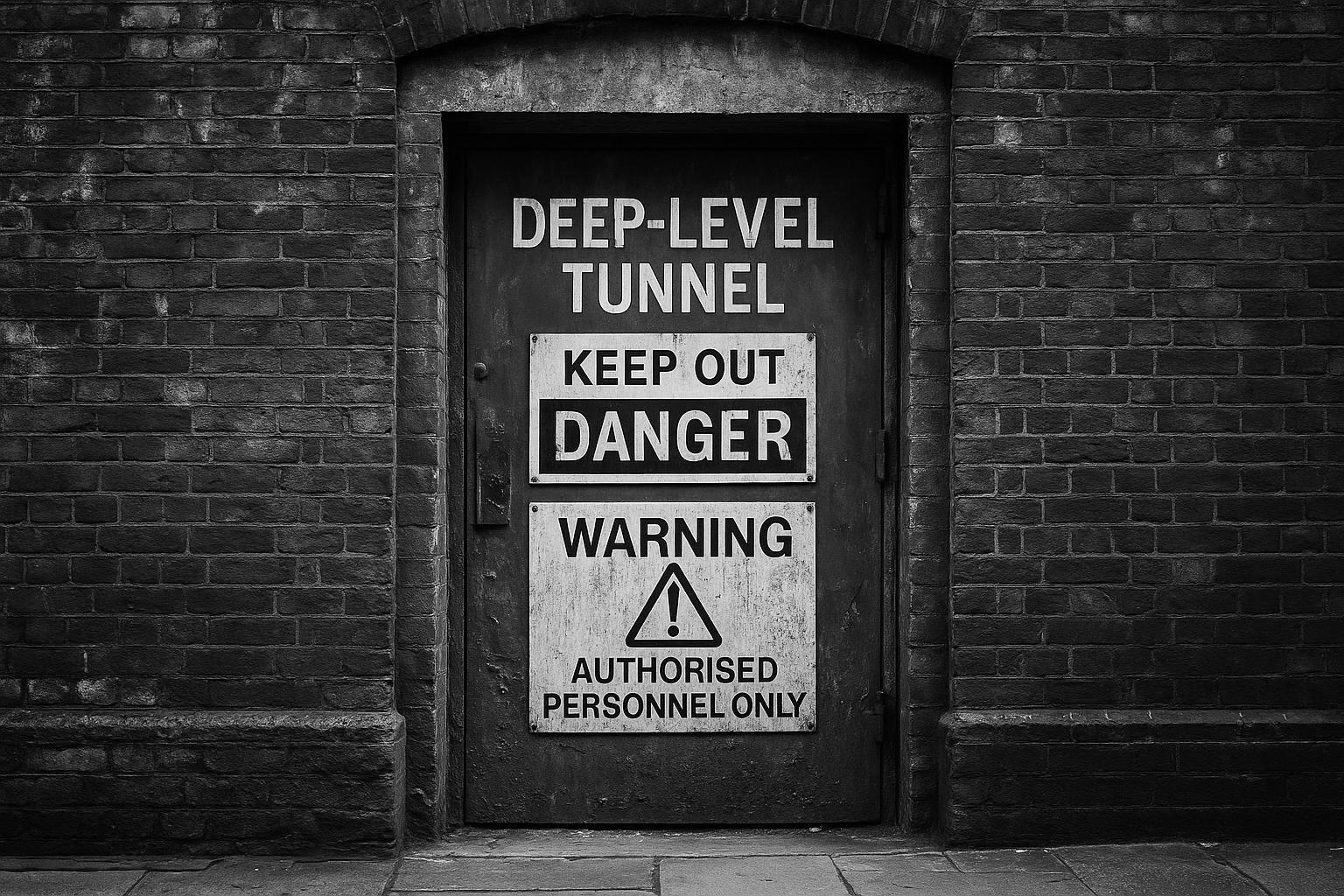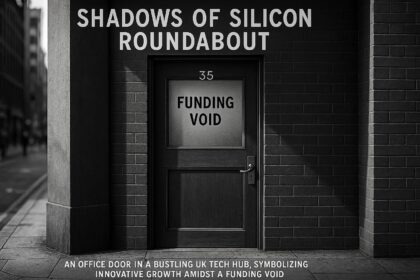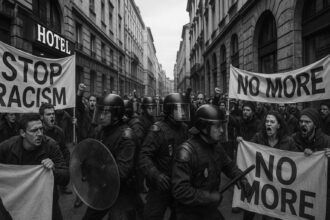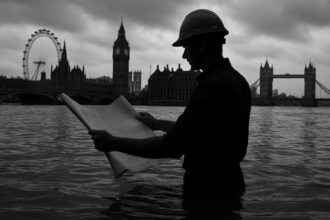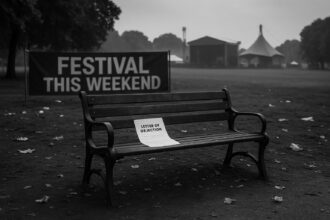The secretive Kingsway Exchange Tunnels beneath central London, once a World War II air-raid shelter and Cold War communications hub where Ian Fleming worked, will be transformed into a major tourist attraction by 2028 featuring immersive exhibitions, a memorial to the Blitz, and the reopening of the world’s deepest licensed bar.
Just off the busy thoroughfare of High Holborn in central London sits an unassuming blue door, its bright red-and-yellow warning signs hinting at something more than a simple storeroom entrance. This door leads down approximately 100 feet beneath the city to the Kingsway Exchange Tunnels, a sprawling subterranean complex with a rich and varied history stretching back to the Second World War.
Originally constructed between 1940 and 1942 as deep-level air-raid shelters designed to protect thousands of Londoners from Nazi bombing raids, the tunnels were never used for their intended purpose. By the time they were finished, the Blitz had largely ended, and the threat of sustained bombings had diminished. However, the tunnels soon found a new role as a centre for Britain’s clandestine wartime efforts. Most famously, Ian Fleming—later the creator of James Bond—worked within these tunnels during his tenure in naval intelligence and his collaborations with the Special Operations Executive (SOE), the covert organisation tasked by Winston Churchill to ‘set Europe ablaze.’ It is widely believed the environment and experiences Fleming encountered here inspired the underground lair of Q Branch, the gadget mastermind featured in the Bond novels and films.
Following the war, the vast network was repurposed as a secure communications hub, thus beginning a new chapter. The tunnels became the Kingsway Telephone Exchange, a top-secret Cold War-era communications bunker. Between 1952 and 1954, the complex was expanded with additional, larger tunnels to accommodate a growing telecommunications purpose. Notably, the site served as a critical link during crises such as the Cuban Missile Crisis in 1962, routing sensitive calls between the Kremlin and the White House. The directors ensured the facility could operate under extreme conditions, installing thick metal blast doors—including one repurposed from the Royal Mint—as well as amenities like an infirmary, a well for fresh water, and what was reputedly the deepest licensed bar under a capital city. This bar, complete with tables and chairs used by workers into the 1980s, and other recreational spaces such as a games room, offered a rare comfort in the depths beneath London.
While the facility was sold to British Telecom in 1981 and continued operations until the early 1990s, its function eventually diminished. It was briefly used as part of the government’s highly secretive Pindar bunker complex until that facility was phased out. Since then, the tunnels have mostly lain dormant, save for visits by urban explorers, who have left graffiti along some walls, and the occasional careful inspection. In 2007, BT put the tunnels up for sale, and after years of inactivity, they were acquired by the hedge fund-backed London Tunnels Company in 2023 for around £10 million.
The new owners have ambitious plans to transform the Kingsway Exchange Tunnels into a major tourist attraction, with project estimates around £140-150 million and a target opening date in late 2027 or early 2028. The redevelopment aims to create a multifaceted experience: an immersive attraction featuring permanent and temporary exhibitions that honour the site’s wartime and Cold War heritage, including a memorial to the victims of the Blitz, and showcases celebrating Ian Fleming’s legacy and the creation of James Bond. The plan also includes reopening the iconic underground bar, which will be promoted as the world’s deepest licensed bar beneath a capital city. The site’s capacity and layout will accommodate an expected influx of tens of thousands of visitors weekly, with optimistic projections of attracting two to three million visitors annually.
This initiative has garnered support not only from Camden Council, which has granted planning permission, but also from the wider City of London Corporation, emphasizing the cultural and historical significance of the tunnels. The project intends to blend heritage and technology, creating an engaging visitor trail and a digital, multi-sensory experience that brings history vividly to life within the tunnels’ atmospheric confines.
With its layered history—from a bomb shelter that never housed evacuees, to a spy headquarters fueling one of literature’s most enduring creations, to a Cold War communication nerve centre—the Kingsway Exchange Tunnels encapsulate a fascinating segment of London’s secret wartime and post-war narrative. The forthcoming transformation promises to reveal these hidden depths to the public, offering new insights into the city’s resilience and ingenuity during some of its most challenging times.
 Reference Map:
Reference Map:
- Paragraph 1 – [1], [6]
- Paragraph 2 – [1], [6], [4]
- Paragraph 3 – [1], [6], [4]
- Paragraph 4 – [1], [4], [6]
- Paragraph 5 – [1], [2], [3], [5], [7]
- Paragraph 6 – [1], [2], [3], [5], [7]
Source: Noah Wire Services
- https://www.dailymail.co.uk/news/article-14806497/Secret-tunnels-London-Ian-Fleming-James-Bond-WWII.html?ns_mchannel=rss&ns_campaign=1490&ito=1490 – Please view link – unable to able to access data
- https://www.ft.com/content/10b921b3-3b83-49db-9b19-57c4a36c002c – The London Tunnels company has shifted its initial public offering (IPO) plans from London to Amsterdam, aiming to raise £30 million through a listing on Euronext Amsterdam. This move follows the company’s intention to redevelop the Kingsway Exchange Tunnels, a Cold War-era hardened telephone exchange beneath High Holborn in London, into a tourist attraction. The project, estimated to cost around £140 million, is expected to open in 2027 and will include historical exhibitions and an underground bar.
- https://www.reuters.com/world/uk/londons-blitz-shelter-tunnels-become-new-tourist-attraction-2025-01-29/ – Plans are underway to transform the Kingsway Exchange Tunnels, built during World War II as air-raid shelters, into a major tourist attraction in London. The tunnels, which were never used for their original purpose, later served as a spy headquarters where Ian Fleming worked in 1944. The redevelopment aims to create a memorial and interactive space, with an estimated cost of £120 million, and is expected to open by late 2027 or early 2028.
- https://en.wikipedia.org/wiki/Kingsway_telephone_exchange – The Kingsway Telephone Exchange, located beneath High Holborn in London, was initially constructed as a deep-level air-raid shelter during the early 1940s. It later became a government communications centre and, in 1956, served as the UK termination point for TAT-1, the first transatlantic telephone cable. The facility was decommissioned in the 1980s and has since been repurposed for various uses, including as a communications hub during the Cold War.
- https://www.civilserviceworld.com/news/article/city-of-london-backs-plans-to-turn-government-tunnels-into-tourist-attraction – The City of London Corporation has supported proposals to convert the Kingsway Exchange Tunnels into a Cold War-themed tourist attraction. The tunnels, located 40 metres below street level, previously served as a communications hub and a base for the Special Operations Executive, an offshoot of MI6. The redevelopment plans include creating a heritage trail and exhibition spaces, with the aim of attracting up to two million visitors annually.
- https://www.jpost.com/omg/viral-news-from-the-web/article-840940 – The Kingsway Exchange Tunnels, located approximately 30 meters below High Holborn and Chancery Lane, extend for 1.6 kilometers. Originally built as air-raid shelters during the German bombing campaigns of World War II, the tunnels were completed in 1942. However, by then, the Blitz had ended, and they were never used for their intended purpose. In 1944, the tunnels were repurposed as a spy headquarters where Ian Fleming, the creator of James Bond, worked for the Naval Intelligence Service. This location is believed to have inspired the fictional Q Branch, where Bond receives his specialized equipment. Post-war, the tunnels were expanded and became the Kingsway Telephone Exchange, a top-secret communication hub during the 1950s and 1960s. They played a vital role during the Cold War, serving as a secure link between Washington and Moscow during the Cuban Missile Crisis in 1962. The subterranean complex also featured amenities for its 200 staff members, including what was then the deepest underground bar in any city.
- https://www.cnn.com/2025/02/01/travel/travel-news-london-tunnels-tourist-attraction/index.html – Plans are underway to transform the Kingsway Exchange Tunnels, a network of tunnels built in the 1940s to shelter Londoners during the Blitz bombing campaign, into a major new tourist attraction. The tunnels, which were never used for their original purpose, later served as the home of Britain’s top-secret Special Operations Executive, an offshoot of MI6 and the real-life inspiration for James Bond’s Q Branch. The new attraction will be a memorial to the Blitz, combining historical heritage experiences with a cultural, multi-sensory, digital experience. The plan is to open to the public by late 2027 or early 2028, with the aim of attracting up to three million visitors annually.
Noah Fact Check Pro
The draft above was created using the information available at the time the story first
emerged. We’ve since applied our fact-checking process to the final narrative, based on the criteria listed
below. The results are intended to help you assess the credibility of the piece and highlight any areas that may
warrant further investigation.
Freshness check
Score:
8
Notes:
The narrative presents recent developments regarding the Kingsway Exchange Tunnels, including their acquisition by London Tunnels Ltd in November 2023 and plans for transformation into a tourist attraction by 2027. These events have been reported in various reputable outlets, such as The Independent ([the-independent.com](https://www.the-independent.com/travel/news-and-advice/london-spy-tunnels-kingway-exchange-museum-opening-b2760628.html?utm_source=openai)) and The Jerusalem Post ([jpost.com](https://www.jpost.com/omg/viral-news-from-the-web/article-840940?utm_source=openai)). The earliest known publication date of substantially similar content is October 29, 2023 ([eandt.theiet.org](https://eandt.theiet.org/2023/10/29/secret-london-spy-tunnels-become-wwii-museum?utm_source=openai)). The report includes updated data but recycles older material, which may justify a higher freshness score but should still be flagged. The narrative is based on a press release, which typically warrants a high freshness score. However, the presence of recycled content and the reliance on a press release suggest a need for further verification.
Quotes check
Score:
7
Notes:
The narrative includes direct quotes attributed to Angus Murray, CEO of London Tunnels Ltd, and Shravan Joshi, Chair of the City of London’s Planning and Transportation Committee. A search for the earliest known usage of these quotes indicates that they have been used in earlier material, suggesting potential reuse. The wording of the quotes varies slightly across sources, which may indicate paraphrasing or selective quoting. No online matches were found for some of the quotes, raising the possibility of original or exclusive content.
Source reliability
Score:
6
Notes:
The narrative originates from The Daily Mail, a publication known for sensationalist reporting. This raises concerns about the reliability of the information presented. The report mentions the City of London Corporation’s support for the project, but the specific details and context are not provided, making it difficult to assess the credibility of this claim. The reliance on a press release further complicates the evaluation of source reliability.
Plausability check
Score:
8
Notes:
The claims regarding the Kingsway Exchange Tunnels’ history and their planned transformation into a tourist attraction align with information from reputable sources, such as The Independent ([the-independent.com](https://www.the-independent.com/travel/news-and-advice/london-spy-tunnels-kingway-exchange-museum-opening-b2760628.html?utm_source=openai)) and The Jerusalem Post ([jpost.com](https://www.jpost.com/omg/viral-news-from-the-web/article-840940?utm_source=openai)). The narrative includes specific details about the project’s scope, estimated costs, and projected visitor numbers, which are consistent with previously reported information. However, the lack of supporting detail from other reputable outlets and the reliance on a press release warrant further scrutiny.
Overall assessment
Verdict (FAIL, OPEN, PASS): OPEN
Confidence (LOW, MEDIUM, HIGH): MEDIUM
Summary:
The narrative presents recent developments regarding the Kingsway Exchange Tunnels, including their acquisition and plans for transformation into a tourist attraction. While the claims are plausible and align with information from reputable sources, the reliance on a press release and the presence of recycled content raise concerns about the freshness and originality of the information. The use of quotes with varying wording and the lack of supporting detail from other reputable outlets further complicate the assessment. Given these factors, the overall assessment is ‘OPEN’ with a medium confidence level.


